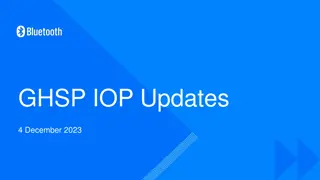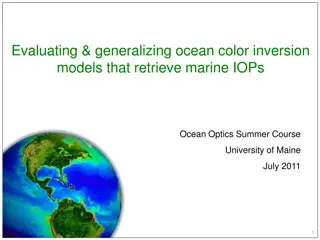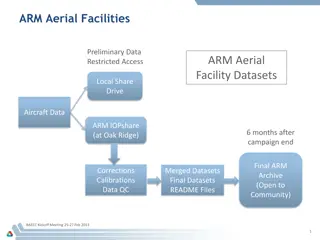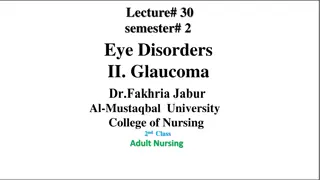
Octupole Collectivity in Nuclei and Coulomb Excitation
Explore the origins and measurements of octupole collectivity in 144Ba, along with experiments versus theory in octupole correlations. Learn about Coulomb excitation processes and the use of GOSIA for modeling excitation and de-excitation. Discover how 144Ba excitation and de-excitation transitions provide insights into octupole deformations and nuclear structure.
Download Presentation

Please find below an Image/Link to download the presentation.
The content on the website is provided AS IS for your information and personal use only. It may not be sold, licensed, or shared on other websites without obtaining consent from the author. If you encounter any issues during the download, it is possible that the publisher has removed the file from their server.
You are allowed to download the files provided on this website for personal or commercial use, subject to the condition that they are used lawfully. All files are the property of their respective owners.
The content on the website is provided AS IS for your information and personal use only. It may not be sold, licensed, or shared on other websites without obtaining consent from the author.
E N D
Presentation Transcript
Measurements of octupole collectivity in 144Ba Ben Jones University of Liverpool
Origins of octupole correlations in nuclei Octupole deformations can be traced back to particle- hole interactions with intruder orbitals of opposite parity with ?, ? = 3, coupled by the octupole interaction. Octupole magic numbers: 34, 56, 88, 134. Octupole deformation is greatest when both proton and neutron numbers are near these octupole magic numbers. Intruder orbitals Lanthanides Actinides [1] Y.Cao et al., Phys Rev C 102 (2020)
Experiment vs theory Several Rn isotopes are shown to behave as octupole vibrators [1], and 222,224,226Ra exhibit static octupole deformation in their ground state [2]. Very little experimental data of the ?(?3) exists for isotopes in the Lanthanide region. Previous measurement of the ?(?3) for 144Ba near by Bucher et al., ANL [3] is significantly enhanced over theory and has a large associated uncertainty. [1] P. A. Butler et al., Nat Commun. 2019 Jun 6;10(1):2473 [2] P. A. Butler et al., Phys. Rev. Lett. 124, 042503 Published 31 January, 2020 [3] B. Bucher et al., Phys. Rev. Lett. 116, 112503 Published 17 March, 2016 [4] S. Y. Xia et al., Phys Rev C 97. 054303 (2017)
Coulomb excitation Projectile and target nuclei excite one another via the Coulomb interaction while following hyperbolic trajectories process can be modelled semi-classically While in each others EM-field both nuclei have a chance to excite via single step, or a series of multi-step transitions Direct probe for EM (E1, E2, E3, M1 ) M.E. s coupling states in a nucleus
144Ba Excitation ?2 and ?3 transitions dominate the excitation process Magnitude of the 3 | ?3 |0+ M.E. is an unambiguous measure of octupole collectivity 3 | ?3 |0+ 2 7 ? ?3;3 0+=
144Ba De-excitation ?2 and ?1 transitions dominate the de-excitation process i.e. the observed -rays 3 2+ -ray yield experimental observable used to probe occupation of the 3- state
GOSIA Used to model both excitation and de-excitation process Integrates over target thickness and scattering angles, considering the geometry and efficiency of the detector setup Fits the matrix elements to the experimental particle-gated -ray yields and additional spectroscopic data ?? ?? ?? ?? ??
HIE-ISOLDE 1.4 GeV proton beam directed into thick primary targets yielding a variety of atomic fragments Separators used to extract nuclei of specific mass RIB re-accelerated up to 10 MeV/u and delivered to experiments MINIBALL ISS
MINIBALL HPGe clusters centred around the target position, plus a position sensitive silicon CD detector placed downstream of the target
Experimental data Three experiments performed on 144Ba over 2017 and 2024 with a mix of beam energies and target isotope to cover a greater centre-of-mass scattering angle, gaining sensitivity to the angular distributions of the excitation: Beam E = 4.21 MeV/u, Target : 208Pb Beam E = 4.52 MeV/u, Target : 208Pb Beam E = 3.40 MeV/u, Target : 58Ni
Particle gating -rays are doppler corrected for the coincident projectile/target nucleus Gating on both the projectile and target effectively increases the lab angle coverage of the CD detector 144Ba 208Pb
Particle gated spectra 2+ 0+ 4+ 2+ 6+ 4+ 8+ 6+ 5 4+ 10+ 8+ 3 2+ 1 2+ Singles and - yields checked for consistency for low yield peaks 208Pb target favours multistep excitation and has higher Coulomb excitation cross section 2+ 0+ 4+ 2+ 6+ 4+ 5 4+ 1 2+ 3 2+ 58Ni target favours single step excitation and has fewer counts, but cleaner spectrum
GOSIA 2minimisation Data normalised to known lifetime of the 4+ 2+ in 144Ba 2scan of 3 | ?3 |0+, all other M.E. s are allowed to vary during the minimisation 3 | ?3 |0+ 2 7 ? ?3;3 0+=
Measured ? ?3;3 0+ Extracted B(E3) consistent with current theory Systematic errors yet to be included (Beam energy, target thickness etc.) References: [1] S. Y. Xia et al., Phys. Rev. C 96, 054303 (2017) [2] R. N. Bernard, L. M. Robledo and T. R. Rodr guez, Phys. Rev. C 93, 061302 (2016) [3] J. Egido and L.M. Robledo, Nucl. Phys. A 518, 475 (1990) [4] J. Egido and L.M. Robledo, Nucl. Phys. A 545, 589 (1992) [5] L. M. Robledo, M. Baldo, P Schuk, and T. R. Rodr guez, Phys. Rev. C 81, 034315 (2010) [6] K. Nomura, D. Vretenar, T. Nik i and Bing-Nan Lu, Phys. Rev. C 89, 024312 (2014) [7] K. Nomura, T. Nik i and D. Vretenar, Phys. Rev. C 97 024317 (2014) [8] X. Yin, M. Q. Lin, C. Ma, and Y. M. Zhao, Phys. Rev. C 111, 044310 (2025) [9] B. Bucher et al., Phys. Rev. Lett. 116. 112503 (2016) [10] B. Bucher et al., Phys. Rev. Lett. 118. 152504 (2017)
Outlook Complementary analysis of the 2+ 0+ lifetime from this dataset compare ratio of doppler shifted and unshifted (2+ 0+) yield GOSIA analysis of isobaric contaminants in the beam (144Sm and 144Nd) will provide consistency check with previous B(E2) and B(E3) measurements Data from 144Ba(d,d ) measurement at ISS to extract deformation lengths, ??, currently being analysed will hopefully provide an independent measurement B(E3)
Thanks for listening and thanks to all the collaborators!
Doppler shifted and unshifted (2+ 0+) (2+ 0+)? ????? (1 ????(???)) 1 ?2 ?(?) ?0 ? ?(2+ 0+) = = ? ? = ?0 (2+ 0+)? ?????+ (2+ 0+)??? ?????
Isobaric contaminants 144Ba(2+ 0+) 144Nd(2+ 0+) 144Sm(2+ 0+)
ISS ISS Setup Setup ISS silicon array placed in the downstream ISS silicon array placed in the downstream position (for the first time) position (for the first time) Target: 200 g/cm2, CD2 Beam Energy: 8.38 MeV/u Magnetic field: 2.5 T Faraday cup for beam tuning CD2 target Faraday cup
ISS data Different charge states of 12C elastically scattering Elastically scattered protons Elastically scattered deuterons
Excitation energy reconstructed from the kinematics 2+ 199 keV 144Ba E2 Slice of events from 570 mm to 684 mm 0+ 0 keV 144Ba(d,d )144Ba(2+): E = 199 keV The 2+ is only visible on the last row due to the resolution and size of the elastic peak. Elastically scattered protons Elastically scattered deuterons
3- 838 keV 1- 759 keV 4+ 530 keV 2+ 199 keV E3 144Ba Slice of events from 312 mm to 684 mm 0+ 0 keV 144Ba(d,d )144Ba(3-): 838 keV Almost the entire detector can be used to see the 3- since its far enough away from the rutherford scattering peak.







